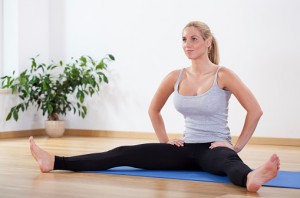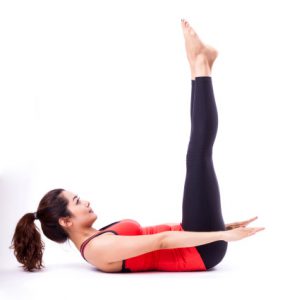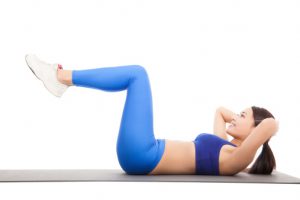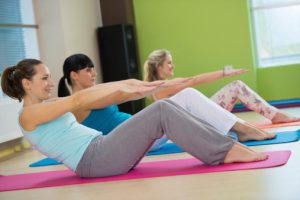Lots of time spent on fitness routines that leave us with little or no results can be incredibly discouraging, especially if you’re going it alone without a personal trainer or exercise physiologist guiding you. It’s easy to make the excuse of ‘I don’t have time’ or ‘I can’t get to there today’ but the truth is, you’re never going to see results that way either.
The following five Pilates exercises are the perfect start to help you ease back into your exercise routine. One thing to remember when starting out in Pilates is that form trumps quality.
1. Breathing
Breathing is incorporated in every pilates exercise and correct breathing is essential to ensure our muscles are supplied with an adequate amount of oxygen.
Benefits:
- Perform exercises with better efficiency
- Stress management and relaxation
- Improved concentration
How to do it:
For this exercise ensure you breathe in through your nose for a count of five. Then, breathe out through your mouth for a count of five, with a ‘shushing’ sound. These breaths should be made in short, rhythmic bursts: in, in, in, in, in, and shush, shush, shush, shush, shush. Remember to never rush your breathing and always ensure you don’t go overboard to the point you feel light headed or you fall over.
2. The Hundred
The first move a beginner will learn is the hundred; this exercise is so named because it takes a count of 100 to complete. The Hundred involves you holding your legs up in a vertical position and pulsing or waving your arms up and down in small motions.
Benefits:
- Improves breathing by expanding your ribcage and lungs
- Develops a strong, flat abdomen
- Strengthens your core and lengthens your spine
- Stimulates your brain and nervous system
How to do it:
To perform the exercise start by lying on your back on a cushioned mat with your legs lifted. Keep your legs at a 45 degree angle if possible, do not force it. Bring your abdominal muscles toward your spine and tighten them as you lift your head, neck and shoulders off the mat, whilst keeping your neck relaxed. With straight arms and your palms facing toward the mat start to pump your arms up and down by your side, these should be small pumps. Pulse your arms 10 times as you continue to breathe correctly in and out. After the 10 pulses, release your neck, head and shoulders back to your mat, and relax your abdominal muscles. When ready, repeat the exercise ten times.
3. Toe Taps
This exercise will target the lower abdominals by adding leg movement.
Benefits:
- Develops lower abdominal stability and protects the lower back
- Strengthens the muscles around the hips
How to do it:
Begin by lying on your back with bent knees and feet flat on the floor. Draw your pubic bone towards your bellybutton thus imprinting your lower back into the mat. One at a time lift your legs to a tabletop position (pictured right) with your knees stacked directly above your hips as your shins are parallel to the ceiling. Whilst doing this move inhale then as you begin to tap one toe toward the floor, moving from the thigh down, exhale. Then, as you lift your leg back to the starting position, inhale. If you can’t keep your shoulder blades off the ground and feel like you’re straining your neck, lay your head down with arms by your side.
To enhance the exercise alternate the motion from side to side, ensuring your legs are back in table top position before you move to the other side. Remember to avoid arching your back by keeping your waist cinched in and do not push yourself, only go as far as you feel comfortable. Repeat the move 10 times on each side.
4. The Roll Up
This is a floor or mat exercise that focuses on your abdominals and improves the flexibility of your spine as you roll up your upper body whilst extending your arms.
Benefits:
- The Pilates roll-up is more effective than the standard crunch when it comes to targeting the “six-pack” muscle
- You engage more muscle fibres
- Strengthens your core and lengthens your back and hamstrings
How to do it:
Begin this exercise by lying on your back with your knees bent. Whilst keeping your feet flat and facing forward stretch your arms out over your head, ensuring that you keep them straight. Stretch your arms toward the ceiling in a forward rolling motion as you inhale. Pull your bellybutton to your spine to tighten your abdominal muscles. Then pull your chin down to your chest as you slowly roll into a sitting position. Keep stretching forward as far and as comfortable as possible as you exhale. Then, in a backward rolling motion release this position whilst inhaling. Repeat this move as many times as you wish.
5. The Saw

This essential move for beginners works on all the rotators of the spine, abdominals and stretches your hamstrings.
Benefits:
- Helps to elongate the spine
- Reduces toxins in the body by encouraging robust breathing and circulation
- Strengthens muscles in your abdominal corset
- Strengthens your back
- Stretches the muscles along the sides of your torso
How to do it:
Begin this exercise by sitting in a v-sit with your feet apart and back straight. Whilst inhaling, bring your arms out to the sides. Your body will form a ‘T’. With your palms facing the ground begin twisting. Whilst twisting, exhale and twist until your right hand reaches your left foot. As you straighten out, inhale. Repeat this motion on the other side.
Want to learn more about how Pilates can help you?
Get in touch with us today if you’re looking for some extra motivation. Bodytrack’s exercise physiologists can give you the guidance you need to achieve your health and fitness goals.




